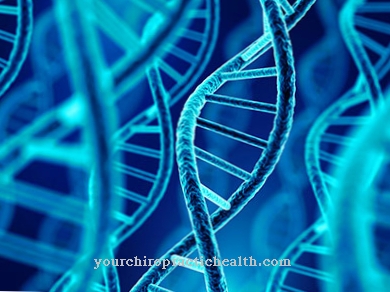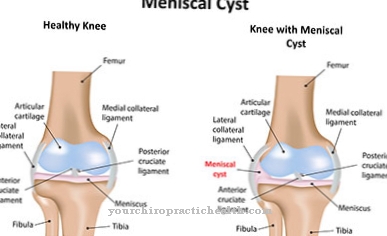The Kawasaki syndrome is an acute febrile illness, which is primarily characterized by inflammatory reactions of the arterial blood vessels with multiple organ involvement and occurs in small children (up to the age of 5). The Kawasaki syndrome is mainly found in Japan and, with increasing frequency, also in Germany (around 9 out of 100,000 children).
What is Kawasaki Syndrome?

© Tomsickova - stock.adobe.com
As Kawasaki syndrome (also mucocutaneous lymph node syndrome) is an acute fever that occurs primarily in infancy, especially between the ages of 2 and 5, and is associated with vasculitis, an inflammation of the smaller and medium-sized blood vessels.
In most cases, the Kawasaki syndrome, which is very similar to other infectious diseases such as scarlet fever or measles, is also manifested in a systemic inflammation of the internal organs.
In addition to the suddenly occurring fever, there are lymph node swellings in the neck and throat (cervical lymphadenopathy), non-purulent conjunctivitis (inflammation of the conjunctiva), stomatitis (inflammation of the oral mucosa) with strawberry tongue or lacquer tongue, a polymorphic rash (not itchy, much rash) as well as scaly erythema (redness) on the hands and feet characteristic of Kawasaki syndrome.
causes
The underlying causes for that Kawasaki syndrome could not yet be clarified.
It is assumed that the Kawasaki syndrome is etiologically due to an infection with as yet unidentified bacteria or viruses, to whose superantigens (toxic proteins of the pathogens) the immune defense of the affected children reacts with pronounced inflammatory reactions as a result of a genetic defect.
The significantly higher incidence (number of new cases) of Kawasaki syndrome in Japan compared to Europe or North America also speaks for a genetic predisposition (disposition).
Symptoms, ailments & signs
Infants and young children with Kawasaki syndrome have severe inflammation of the blood vessels throughout the body. The inflammation causes symptoms such as fever and a rash. Typical of the disease is a gradual rise in body temperature, which is usually associated with chills, fatigue and a general malaise.
The rash is painful redness that can appear in any part of the body and occasionally ulcers or cysts. This can be accompanied by conjunctivitis and swelling of the mucous membranes in the mouth and throat. The red lips and the reddish tongue, also strawberry tongue, are characteristic. With early treatment, affected children will usually recover relatively quickly.
In severe cases, however, the rash can leave scars or lead to permanent loss of sensitivity. If there is no treatment, there is a risk to life. Then the skin changes worsen and the fever increases. Eventually it can lead to heart complications and death of the child. The symptoms usually appear between the ages of one and eight. However, adolescents and young adults can also be affected. Kawasaki syndrome is particularly common in boys.
Diagnosis & course
A Kawasaki syndrome can be diagnosed based on the characteristic symptoms. In addition to the acute high fever, at least four of the main symptoms of the disease must be detectable in order to be able to assume Kawasaki syndrome.
In addition, similar infectious diseases such as measles or scarlet fever should be excluded from the differential diagnosis. The diagnosis is confirmed by a blood analysis. So-called autoantibodies (cANCA), antibodies directed against the body's own antigens, can be detected serologically in the case of Kawasaki syndrome. An increased number of leukocytes (white blood cells) and an increased CRP value (C-reactive protein) also indicate a possible Kawasaki syndrome as markers of inflammation.
Echocardiography (heart ultrasound) should be performed to rule out involvement of the coronary vessels (arterial coronary vessels) or a cardiac aneurysm (protrusion of the arterial coronary vessels).
If left untreated, Kawasaki syndrome can lead to an aneurysm of the heart, which can lead to life-threatening secondary diseases such as myocarditis (inflammation of the heart muscle), infarcts, pericarditis (inflammation of the pericardium) and cardiac arrhythmias, which have a significant effect on long-term mortality (mortality rate). With timely diagnosis and therapy, the prognosis is good and the disease usually heals without complications.
Complications
Kawasaki syndrome in babies and children leads to a very high fever in most cases. Those affected also suffer from red coloring of the skin, lips and tongue. The mucous membranes in the throat and mouth also swell, causing problems when ingesting food and fluids.
Not infrequently, Kawasaki syndrome in babies and children is also associated with a rash all over the body and inflammation of the conjunctiva. The quality of life of the patient is considerably restricted and reduced by this syndrome. If left untreated, the syndrome can also cause discomfort and inflammation of the heart, which can ultimately lead to death.
The treatment itself does not usually lead to any particular complications and the course of the disease is always positive. This is done with the help of drugs that significantly reduce the symptoms and symptoms. If the treatment is successful, there are no further complications or reduced life expectancy. Successful treatment of Kawasaki syndrome in babies and children also does not cause any consequential damage.
When should you go to the doctor?
A doctor's visit is necessary if the fever persists or rises. Reddening of the skin, an increase in heart activity and changes in the appearance of the skin must be assessed and examined by a doctor. Children who suffer from sudden acute symptoms up to the age of 5 that lead to severe impairment of health should be treated by a doctor as soon as possible. Since Kawasaki syndrome in babies and children can lead to premature death in severe cases without medical care, a visit to a doctor is recommended when the first irregularities occur.
Red discoloration of the lips and tongue that resembles the color of strawberries should be examined. Swelling of the lymph, pain in the lymph nodes, or changes in the lining of the mouth and throat should be presented to a doctor. If conjunctivitis develops, a doctor must be consulted. Consult a doctor immediately if the heart rhythm is disturbed. Damage to the heart muscle can occur, which has serious consequences. If the child refuses to eat or drink sufficient fluids, there is a risk of the organism being undersupplied. A doctor's visit is required immediately to prevent a life-threatening condition from developing. If the child shows behavior problems or an increased need for sleep, a doctor should be consulted.
Treatment & Therapy
The therapeutic measures are aimed at one Kawasaki syndrome primarily on reducing inflammatory responses and avoiding aneurysms in the coronary arteries, which are at increased risk of manifesting in the second and third weeks. For this purpose, immunoglobulins, which play an important role in the body's defenses and which children affected by Kawasaki syndrome cannot independently synthesize to a sufficient extent, are infused (2 g / kg body weight over 12 hours).
The therapeutic measure may have to be repeated if the child concerned does not respond adequately. In addition, high-dose acetylsalicylic acid (30 to 100 mg / kg body weight per day) is used to reduce acute inflammation and lower fever. As long as there is or is a risk of a coronary aneurysm, acetylsalicylic acid should continue to be taken in lower doses (2 to 4 mg / kg body weight per day), as the substance has an anticoagulant effect.
In the presence of a pronounced aneurysm, drugs such as coumarins are recommended to inhibit blood clotting. Cardiac surgery may be indicated for Kawasaki syndrome. In addition, cortisone-like drugs are being researched in clinical tests, with at least one additional positive effect for the treatment of Kawasaki syndrome being demonstrated. After the successful end of therapy, regular check-ups with a cardiologist should take place in the case of Kawasaki syndrome in order to rule out long-term impairment of the heart (e.g. stenoses).
Outlook & forecast
The Kawasaki syndrome is a very serious infection that absolutely requires medical treatment in order to avoid complications and possible long-term effects. However, parents of affected children can help alleviate symptoms by simple means.
In most cases, cold calf compresses are sufficient to reduce the fever, they do not help and the fever is dangerously high, a shower can provide relief. A cold shower or a cold full bath should be avoided. The blood vessels in the extremities would narrow quickly and the heart would have to beat faster. This is too heavy a burden for the already loaded circulation. If you instead regulate the temperature slowly and not too far, this leads to a moderate reduction in body temperature and only minimal circulatory stress.
Since children become dehydrated very quickly, it is imperative that parents keep them hydrated. Patients must be slowed down in their physical activity to avoid possible heart damage and subsequent complications. Simply adding fresh or dried turmeric to food helps, thanks to its anti-inflammatory effect, both with fever and with skin rashes that occur, which can also be alleviated with creams.
A regular cardiological check-up after the symptoms have subsided is advisable so that possible late effects can be treated early.
prevention
Due to the unknown etiology (underlying cause) of the Kawasaki syndrome there are no preventive measures.
Aftercare
In most cases, there are no special or direct follow-up options available to those affected with Kawasaki syndrome in babies and children. With this disease, however, a doctor should be consulted very early so that there are no further complications and also no further worsening of the symptoms.
An early diagnosis usually has a very positive effect on the further course of the disease, so that the affected parents should contact a doctor as soon as the first symptoms and signs of Kawasaki syndrome in babies and children appear. The treatment itself is usually done by taking certain medications.
Parents should make sure that the dosage is correct and that the medication is taken regularly. If anything is unclear or if you have any questions, you should always consult a doctor first so that no further complaints arise. In the case of Kawasaki syndrome in babies and children, regular checks and examinations by a doctor are very important in order to permanently monitor the condition of the person concerned. The child should not exert themselves unnecessarily because the heart is generally weak. In many cases, this disease reduces the life expectancy of those affected.
You can do that yourself
Kawasaki syndrome is a serious infectious disease in young children. Medical treatment is necessary to avoid complications and long-term effects. Still, parents can alleviate symptoms by a few means.
The disease is accompanied by a high fever. Calf wraps or moderate whole-body cooling usually lower the body temperature by one to two degrees. Because of the fever, parents should also ensure that their sick child is hydrated enough. Still mineral waters or unsweetened herbal teas are ideal. In order to avoid complications to the heart, physical restraint must be strictly observed. Cooling compresses and the application of anti-inflammatory ointments are recommended for treating the rashes. Coconut oil - which also has an antiseptic effect - or olive oil are recommended as natural substances. Specially prepared preparations can also be purchased in pharmacies.
Naturopathy recommends the homeopathic remedy belladonna for high fever. It is also advisable to give vitamin C preparations, as this vital vitamin is consumed more in an inflammatory process. Turmeric root also has a strong anti-inflammatory effect. Parents can purchase these fresh in the supermarket or in powder or capsule form (dietary supplement) in the pharmacy.
After an illness has been overcome, parents and their child should regularly go to a cardiologist for check-ups in order to promptly identify and treat the occurrence of late effects.





.jpg)
.jpg)

















.jpg)



